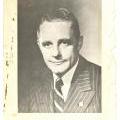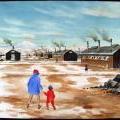For the past few weeks, I have been taking some time off from transcribing documents for the Greenfield digital editing project to work on a 20th-century collections guide. (Dana and I are almost done transcribing the 325 documents that we're using to tell the story of Bankers Trust Company! Yay!)
The creation of such a guide is part of the Greenfield project grant funded by the Albert M. Greenfield Foundation since one of the main goals of the project is to highlight HSP's holdings of 20th-century collections.
Besides the Greenfield digital project, HSP staff is currently working on several projects, such as the Civic Engagement collections project and the Digital Center for Americana, which aim to educate users about its 20th-century holdings as well as provide sufficient access to those holdings. Information about and access to these materials is being established through processing, conservation, digitization and digital documentary editing.
When I took on the task of creating a 20th-century collections guide, I pretty much had no idea what I was getting myself into. I thought there were probably a sizable amount of 20th-century collections, but nothing too crazy. Yeah, turns out HSP has a ridiculous amount!
Because of the vast number of collections, the guide can in no way be comprehensive. Hopefully it will serve to showcase the extensive nature of HSP’s holdings, and help users locate collections that may be of interest to them.
The depth and breadth of HSP's 20th-century collections is truly significant. Dating up through the late 20th century, the collections have both a regional and national scope. They document the greater Philadelphia area, national figures and organizations, as well as individuals and associations that had a nationwide impact. The experiences of diverse segments of society, including African Americans, women, and various ethnic and immigrant groups, are all well represented.
In order to keep the guide at a reasonable size and include the appropriate collections, Matthew Lyons and I established some criteria that I was to follow. The guide will include:
- Only manuscript collections (This excludes materials such as books and periodicals.)
- Collections that have a significant amount of 20th-century materials (Many collections have span dates that include the 20th century, for example, the Chew family papers. However, in these cases, we are only including collections for which most of the materials fall within the 20th century.)
- Collections that have a high research value, based on HSP's surveying methodology
- Collections that are at least1 linear foot (with a few exceptions)
- Collections that have a finding aid or rough inventory (with some exceptions)
Even when following this criteria, I came up with a list of about 400 collections. And again, this list is not comprehensive. There are many more collections that did not make it.
Like the subject guides that are currently on HSP's website, I decided it would make the most sense to organize the 20th century collections topically. Collections fall under one or more of the following categories:
Arts & Culture
Business, industry & finance
Community & social service history
Family life & genealogy
Graphic & visual materials
Law
Politics & government
Race, ethnic & immigrant history
Religion
Science, medicine & technology
Sports, recreation & travel
Wars & military service
Women's history
A couple notable 20th-century collections include:
League of Women Voters of Philadelphia records, 1920-1961(bulk 1941-1959) (Collection 1940) 27 Boxes (38 linear ft.)
In addition to educating the public during election campaigns, the League took stands on local issues concerning child care, city management, housing, public education, public health; national issues of the legal status of women and taxation of oleo margarine; and foreign policy questions including the United Nations and the Marshall Plan. The Philadelphia chapter communicated with the national and state League organizations, politicians, civic leaders, and organizations. Correspondence, board minutes, budget and other committee reports, memoranda, circulars of League of Women Voters of Philadelphia are included in the collection.
 Richardson Dilworth papers, 1881-2000 (bulk 1965-1970) (Collection 3112) 251 Boxes, 19 volumes (101.2 linear ft.)
Richardson Dilworth papers, 1881-2000 (bulk 1965-1970) (Collection 3112) 251 Boxes, 19 volumes (101.2 linear ft.)
Richardson Dilworth (1898-1974) was a major figure in the political reforms of the 1950s, serving first as District Attorney during the Clark administration from 1952-1955 and later as mayor from 1956-1962. His appointment to the Board of Education in 1965 brought about much needed reform to the Philadelphia school system. For the rest of his life, he remained active in civic affairs.
Although the papers include little documentation of Dilworth's law and mayoral careers they do include large amounts of material concerning his Board of Education activities, civic organizations and projects, the Reading Railroad Receivership, and the Pennsylvania Governor's Committee on Transportation.
 Sumiko Kobayashi papers, 1941-1989 (Collection MSS073) 22 Boxes (8.8 linear ft.)
Sumiko Kobayashi papers, 1941-1989 (Collection MSS073) 22 Boxes (8.8 linear ft.)
Sumiko Kobayashi was born in Yamato, a Japanese agricultural community near Palm Beach, Florida, the daughter of Japanese immigrants. Her family was relocated from San Leandro, California under Executive Order 9066 and interned in the Topaz Relocation Center in Utah. Sumiko was allowed to leave the camp in order to attend college through the help of the National Japanese American Student Relocation Council, and graduated from Brothers College, Drew University in Madison, New Jersey in 1946. She was active in many Japanese-American and Asian-American organizations and served as Redress Chair for Pennsylvania of the Japanese American Citizens' League's National Committee on Redress.
The collection includes personal correspondence, documents, and photographs relating to the family's time in the Topaz Relocation Center, and includes records of the organizations in which she has been active. In English and Japanese.
